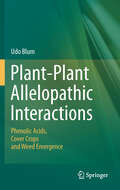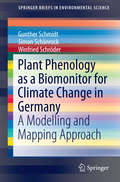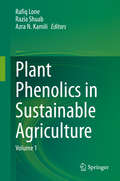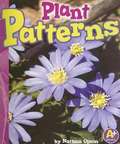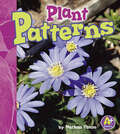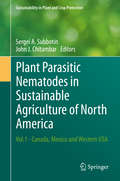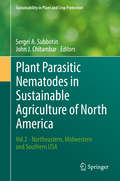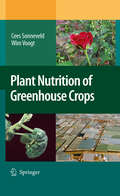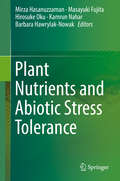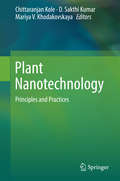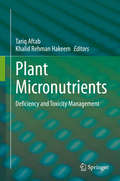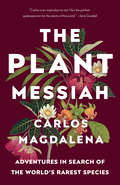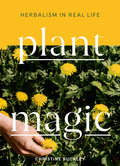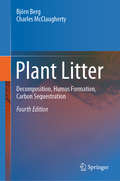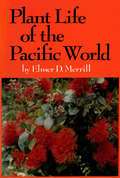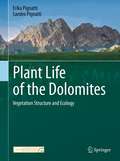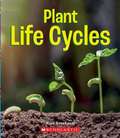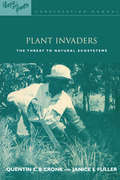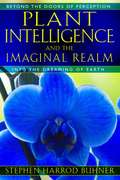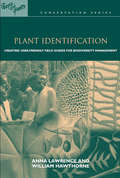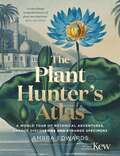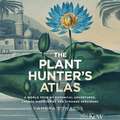- Table View
- List View
Plant-Plant Allelopathic Interactions: Phenolic Acids, Cover Crops and Weed Emergence
by Udo BlumIn an effort to implement conservation measures farmers have used a variety of production methods, including the use of reduced or zero tillage and cover crops. One benefit of these production methods has been early season weed control. The literature suggests that a variety of mechanisms may be involved, among them the allelopathic effects of phenolic acids. This retrospective analysis addresses the following: How likely are phenolic acid concentrations and environmental conditions in wheat no-till cropping systems for the inhibition of annual broadleaf weed emergence? and Do phenolic acids have a dominant role or are they just one component of a larger promoter/modifier/inhibitor complex? The book covers allelopathic plant-plant interactions, laboratory and field experiments, and future research. It uses a journal format, provides justifications for procedures used, if-then hypotheses, and cons and pros so that readers can reach their own conclusions.
Plant Phenology as a Biomonitor for Climate Change in Germany
by Gunther Schmidt Simon Schönrock Winfried SchröderThe investigations refer to the development of plant phenology since the 1960s in Germany. Spatiotemporal trends were assessed by means of regression kriging. It could be shown that there already is a distinct shift of phenological onset towards the beginning of the year of up to two weeks. In future, a shift of up to one month was calculated till 2080. Moreover, a prolongation of the vegetation period of up to three weeks was found. The findings are relevant for the development of mitigation measures to prevent from environmental, agricultural and economic issues due to climate change.
Plant Phenolics in Sustainable Agriculture: Volume 1
by Rafiq Lone Razia Shuab Azra N. KamiliThis book presents the latest research on plant phenolics, offering readers a detailed, yet comprehensive account of their role in sustainable agriculture. It covers a diverse range of topics, including extraction processes; the role of plant phenolics in growth and development; plant physiology; post-harvesting technologies; food preservation; environmental, biotic and abiotic stress; as well as nutrition and health. Further the book provides readers with an up-to-date review of this dynamic field and sets the direction for future research. Based on the authors’ extensive experience and written in an engaging style, this highly readable book will appeal to scholars from various disciplines. Bringing together work from leading international researchers, it is also a valuable reference resource for academics, researchers, students and teachers wanting to gain insights into the role of plant phenolics in sustainable agriculture.
Plant Patterns (Finding Patterns Ser.)
by Nathan OlsonSimple text introduce different kinds of plant patterns.
Plant Parasitic Nematodes in Sustainable Agriculture of North America: Vol. 1 - Canada, Mexico And Western Usa (Sustainability In Plant And Crop Protection Ser.)
by Sergei A. Subbotin John J. ChitambarPlant-parasitic nematodes are recognized as one of the greatest threats to crop production throughout the world. Estimated annual crop losses of $8 billion in the United States and $78 billion worldwide are attributed to plant parasitic nematodes. Plant parasitic nematodes not only cause damage individually but form disease-complexes with other microorganisms thereby increasing crop loss. Nematode diseases of crops are difficult to control because of their insidious nature and lack of specific diagnostic symptoms which closely resemble those caused by other plant pathogens and abiotic diseases. Future developments of sustainable management systems for preventing major economical agricultural losses due to nematodes is focused on strategies that limit production costs, enhance crop yields, and protect the environment. This book presents a first compendium and overview for nematode problems and their management across North America. Each chapter provides essential information on the occurrence and distribution of plant parasitic nematodes, their major crop hosts, impact on crop production and sustainable management strategies for each region of the continent including, Canada, Mexico and all states of the USA. For each region, a thematic overview of changes in crop production affected by plant parasitic nematodes and their management strategies over time will provide invaluable information on the important role of plant parasitic nematodes in sustainable agriculture.
Plant Parasitic Nematodes in Sustainable Agriculture of North America: Vol. 1 - Canada, Mexico And Western Usa (Sustainability In Plant And Crop Protection Ser.)
by Sergei A. Subbotin John J. ChitambarPlant-parasitic nematodes are recognized as one of the greatest threats to crop production throughout the world. Estimated annual crop losses of $8 billion in the United States and $78 billion worldwide are attributed to plant parasitic nematodes. Plant parasitic nematodes not only cause damage individually but form disease-complexes with other microorganisms thereby increasing crop loss. Nematode diseases of crops are difficult to control because of their insidious nature and lack of specific diagnostic symptoms which closely resemble those caused by other plant pathogens and abiotic diseases. Future developments of sustainable management systems for preventing major economical agricultural losses due to nematodes is focused on strategies that limit production costs, enhance crop yields, and protect the environment. This book presents a first compendium and overview for nematode problems and their management across North America. Each chapter provides essential information on the occurrence and distribution of plant parasitic nematodes, their major crop hosts, impact on crop production and sustainable management strategies for each region of the continent including, Canada, Mexico and all states of the USA. For each region, a thematic overview of changes in crop production affected by plant parasitic nematodes and their management strategies over time will provide invaluable information on the important role of plant parasitic nematodes in sustainable agriculture.
Plant Nutrition of Greenhouse Crops
by Wim Voogt Cees SonneveldGreenhouse cultivation is noted for its high uptake of minerals, consistent climatic conditions, exclusion of natural precipitation and control of salt accumulation. Acknowledging that plant nutrition in greenhouse cultivation differs in many essentials from field production, this volume details specific information about testing methods for soils and substrates in a greenhouse environment. It does so while offering a universally applicable analysis. This is based on the composition of the soil and substrate solutions, methods for the interpretation of tissue tests, and crop responses on salinity and water supply in relation to fertilizer application. Fertilizer additions, related to analytical data of soil and substrate samples, are presented for a wide range of vegetable and ornamental crops. The subject is especially apt now as substrate growing offers excellent possibilities for the optimal use of water and nutrients, as well as the potential for sustainable production methods for greenhouse crops.
Plant Nutrients and Abiotic Stress Tolerance
by Masayuki Fujita Mirza Hasanuzzaman Hirosuke Oku Kamrun Nahar Barbara Hawrylak-NowakThis book discusses many aspects of plant-nutrient-induced abiotic stress tolerance. It consists of 22 informative chapters on the basic role of plant nutrients and the latest research advances in the field of plant nutrients in abiotic stress tolerance as well as their practical applications. Today, plant nutrients are not only considered as food for plants, but also as regulators of numerous physiological processes including stress tolerance. They also interact with a number of biological molecules and signaling cascades. Although research work and review articles on the role of plant nutrients in abiotic stress tolerance have been published in a range of journals, annual reviews and book chapters, to date there has been no comprehensive book on this topic. As such, this timely book is a valuable resource for a wide audience, including plant scientists, agronomists, soil scientists, botanists, molecular biologists and environmental scientists.
Plant Nanotechnology
by Chittaranjan Kole D. Sakthi Kumar Mariya V. KhodakovskayaThis book highlights the implications of nanotechnology in plant sciences, particularly its potential to improve food and agricultural systems, through innovative, eco-friendly approaches, and as a result to increase plant productivity. Topics include various aspects of nanomaterials: biophysical and biochemical properties; methods of treatment, detection and quantification; methods of quantifying the uptake of nanomaterials and their translocation and accumulation in plants. In addition, the effects on plant growth and development, the role of nanoparticles in changes in gene and protein expression, and delivery of genetic materials for genetic improvement are discussed. It also explores how nanotechnology can improve plant protection and plant nutrition, and addresses concerns about using nanoparticles and their compliances. This book provides a comprehensive overview of the application potential of nanoparticles in plant science and serves as a valuable resource for students, teachers, researchers and professionals working on nanotechnology.
Plant Migration: The Dynamics of Geographic Patterning in Seed Plant Species
by Jonathan D. SauerUsing cases of plant migration documented by both historical and fossil evidence, Jonathan D. Sauer provides a landmark assessment of what is presently known, and not merely assumed, about the process.
Plant Micronutrients: Deficiency and Toxicity Management
by Khalid Rehman Hakeem Tariq AftabPlants require essential nutrients (macronutrients and micronutrients) for normal functioning. Sufficiency range is the levels of nutrients necessary to meet the plant’s needs for optimal growth. This range depends on individual plant species and the particular nutrient. Nutrient levels outside of a plant’s sufficiency range cause overall crop growth and health to decline, due either to deficiency or toxicity from over-accumulation. Apart from micronutrients (B, Cl, Mn, Fe, Zn, Cu and Mo), Aluminum (Al), cerium (Ce), cobalt (Co), iodine (I), lanthanum (La), sodium (Na), selenium (Se), silicon (Si), titanium (Ti), and vanadium (V) are emerging as novel biostimulants that may enhance crop productivity and nutritional quality. These beneficial elements are not "essential" but when supplied at low dosages, they augment plant growth, development, and yield by stimulating specific molecular, biochemical, and physiological pathways in responses to challenging environments.The book is the first reference volume that approaches plant micronutrient management with the latest biotechnological and omics tools. Expertly curated chapters highlight working solutions as well as open problems and future challenges in plant micronutrient deficiency or toxicity. We believe this book will introduce readers to state-of-the-art developments and research trends in this field.
The Plant Messiah: Adventures in Search of the World's Rarest Species
by Carlos MagdalenaAn impassioned memoir of saving extraordinary plants on the brink of extinction, by a scientist who has been called a "codebreaker" (Telegraph) and "an inspiration" (Jane Goodall)Carlos Magdalena is not your average horticulturist. He's a man on a mission to save the world's most endangered plants. First captivated by the flora of his native Spain, he has travelled to the remotest parts of the globe in search of exotic species. Renowned for his pioneering work, he has committed his life to protecting plants from man-made ecological destruction and thieves hunting for wealthy collectors.In The Plant Messiah, Magdalena takes readers from the Amazon to the jungles of Mauritius to deep within the Australian Outback in search of the rare and the vulnerable. Back in the lab, we watch as he develops groundbreaking, left-field techniques for rescuing species from extinction, encouraging them to propagate and thrive once again. Along the way, he offers moving, heartfelt stories about the secrets contained within these incredible organisms. Passionate and absorbing, The Plant Messiah is a tribute to the diversity of life on our planet, and the importance of preserving it.*Featuring 16 pages of color photos*
Plant Man: The Life and Art of Makoto Azuma (Fountas & Pinnell Classroom, Guided Reading Grade 6)
by Nicole WalkerFrom Guitars to FLOWERS When a young rock musician struggled to pay his bills, he was forced to take a job doing something he never thought he'd do: work in a flower shop. But that fateful turn of events changed Makoto Azuma's life forever. His job soon evolved into a passion for transforming flowers into art. Now, his amazing and outrageous artwork never fails to surprise and delight audiences around the world. NIMAC-sourced textbook
Plant Magic: Herbalism in Real Life
by Christine BuckleyA fun, modern, and irreverent introduction to healing herbs, this field guide to feeling good includes more than 20 plant profiles.Here is an invitation to the wild world of healing plants growing right outside your door. Highlighting herbs from catnip and plantain to nettles and rosemary, this book provides the information you need to assemble an herbal arsenal for combatting any ailment—everything from brewing up a slick lube tea for sexual health to fashioning a simple summer band-aid from backyard &“weeds&” to crafting an herbal smoking blend to quiet a busy mind. This accessible guide covers questions like: What is plant medicine? What can I put in my mouth and where do I find it? Can I still go to my doctor? We&’ve got you covered.
Plant Litter: Decomposition, Humus Formation, Carbon Sequestration
by Björn Berg Charles McClaughertyThis book gives basic facts about litter decomposition studies, which are of guidance for scientists who start studies. Since the publication of the third edition, there has been quite a development not only in the field of litter decomposition but also in supporting branches of science, which are important for fruitful work on and understanding of decomposition of plant litter and sequestration of carbon. A consequence is that ‘old established truths’ are becoming outdated. New knowledge in the fields of phytochemistry and microbial ecology has given a new baseline for discussing the concepts ‘litter decomposition’ and ‘carbon sequestration’. We can also see a rich literature on litter decomposition studies using roots and wood as substrates. These have given new insights in factors that regulate the decomposition rate and as regards roots their contribution to sequestered carbon in humus. Additional facts on the role of temperature vs the litters’ chemical composition may in part change our view on effects of climate change. Further information on applications of the new analytical technique (13C-NMR) for determining organic-chemical compounds has allowed us to develop these parts. Focus is laid on needle litter of Scots pine as a model substrate as this species has been considerably more studied than other litter species. Also the boreal/northern temperate coniferous forest has in part been given this role. Still, new information may allow us to develop information about litter from further tree species.
Plant Life of the Pacific World
by Elmer D. MerrillThis Asian ecology book offers an overview of the plant life of the vast Pacific region.Among the topics covered are the tropical forest and jungles, the grasslands, the primary and secondary forest, and the plants of the seashores. <P><P>Weeds and cultivated plants are also discussed with overviews of plant distribution and notes on specific islands and island groups.Plant Life of the Pacific World will fill a great need as an important reference source not only for the ethnobotanist but for the professional botanist and the student interested in the flora of the Pacific basin. The information it contains-adequately detailed and clearly presented-should also open the eyes of both visitors and inhabitants to the natural riches of the Pacific region.
Plant Life of the Dolomites
by Sandro Pignatti Erika PignattiThis volume provides an in-depth analysis of over 100 plant communities of the Dolomite vegetation. The data is based on the phytosociological relevés, which have been collected by the authors in nearly 2000 surveys. The key part consists of approx. 130 association tables presenting plant sociological data for the respective plant communities. Thus, this volume perfectly complements the successful main volume "Plant Life of the Dolomites: Vegetation Structure and Ecology," which features summarized, synoptic association tables of the twelve habitats. In addition, geo-referenced locations of relevés and detailed ecological measures are provided. A further part describes the individual components of the fascinating dolomitic landscape (Heritage of all Humanity) and presents tables of vegetation complexes, which summarize the more than 400 surveys carried out in the Dolomites. The structure of this supplementary volume corresponds to that of the main volume with a key part consisting of twelve chapters, each describing a specific habitat, and a total of 106 associations. Several topics covered in the main volume, such as the exploration of the flora, ecological factors and syntaxonomy are discussed further here.
Plant Life Cycles (A True Book)
by Mara GrunbaumIncredible Plants series introduces young investigative readers to many types of unusual and typical plants from photosynthesis, how they grow, and ways they survive in extreme environments.
Plant Invaders: The Threat to Natural Ecosystems (People and Plants International Conservation #Vol. 1)
by Quentin C.B. Cronk Janice L. FullerA practical guide to the protection and management of ecosystems against invasions by non-indigenous plant species. The authors seek to offer an accessible account of the subject and how to protect natural habitats. The majority of countries suffer from invasive plants and there are case studies from North America, Europe, Australia, South and South East Asia and the Pacific and Atlantic islands. There is also a list of invasive species, with their countries of origin and regions of introduction.
Plant Intelligence and the Imaginal Realm: Beyond the Doors of Perception into the Dreaming of Earth
by Stephen Harrod BuhnerA manual for opening the doors of perception and directly engaging the intelligence of the Natural World • Provides exercises to directly perceive and interact with the complex, living, self-organizing being that is Gaia • Reveals that every life form on Earth is highly intelligent and communicative • Examines the ecological function of invasive plants, bacterial resistance to antibiotics, psychotropic plants and fungi, and the human species In Plant Intelligence and the Imaginal Realm, Stephen Harrod Buhner reveals that all life forms on Earth possess intelligence, language, a sense of I and not I, and the capacity to dream. He shows that by consciously opening the doors of perception, we can reconnect with the living intelligences in Nature as kindred beings, become again wild scientists, nondomesticated explorers of a Gaian world just as Goethe, Barbara McClintock, James Lovelock, and others have done. For as Einstein commented, “We cannot solve the problems facing us by using the same kind of thinking that created them.” Buhner explains how to use analogical thinking and imaginal perception to directly experience the inherent meanings that flow through the world, that are expressed from each living form that surrounds us, and to directly initiate communication in return. He delves deeply into the ecological function of invasive plants, bacterial resistance to antibiotics, psychotropic plants and fungi, and, most importantly, the human species itself. He shows that human beings are not a plague on the planet, they have a specific ecological function as important to Gaia as that of plants and bacteria. Buhner shows that the capacity for depth connection and meaning-filled communication with the living world is inherent in every human being. It is as natural as breathing, as the beating of our own hearts, as our own desire for intimacy and love. We can change how we think and in so doing begin to address the difficulties of our times.
Plant Identification: Creating User-Friendly Field Guides for Biodiversity Management
by Anna Lawrence William HawthorneAn important prerequisite for successful conservation is a good understanding of what we seek to conserve. Nowhere is this more the case than in the fight to protect plant biodiversity, which is threatened by human activity in many regions worldwide. This book is written in the belief that tools that enable more people to understand biodiversity can not only aid protection efforts but also contribute to rural livelihoods. Among the most important of those tools is the field guide. Plant Identification provides potential authors of field guides with practical advice about all aspects of producing user-friendly guides which help to identify plants for the purposes of conservation, sustainable use, participatory monitoring or greater appreciation of biodiversity. The book draws on both scientific and participatory processes, supported by the experience of contributors from across the tropics. It presents a core process for producing a field guide, setting out key steps, options and techniques available to the authors of a guide and, through illustration, helps authors choose methods and media appropriate to their context.
The Plant-Hunter's Atlas: A World Tour of Botanical Adventures, Chance Discoveries and Strange Specimens
by Ambra Edwards'A refreshingly insightful history of plant introductions.' - Roy Lancaster Travel the world with extraordinary tales of the botanical discoveries that have shaped empires, built (and destroyed) economies, revolutionised medicine and advanced our understanding of science.Circling the globe from Australia's Botany Bay to the Tibetan plateau, from the deserts of Southern Africa to the jungles of Brazil, this book presents an incredible cast of characters - dedicated researchers and reckless adventurers, physicians, lovers and thieves. Meet dauntless Scots explorer David Douglas and visionary Prussian thinker Alexander von Humboldt, the 'Green Samurai' Mikinori Ogisu and the intrepid 17th century entomologist Maria Sibylla Merian - the first woman known to have made a living from science.Beautifully illustrated with over 100 botanical artworks from the archives of the Royal Botanic Gardens, Kew, this absorbing book tells the stories of how plants have travelled across the world - from the missions of the Pharaohs right up to 21st century seed-banks and the many new and endangered species being named every year.***THE ROYAL BOTANIC GARDENS, KEW is a world-famous research organisation and a major international visitor attraction. It harnesses the power of its science, the rich diversity of its gardens and collections to unearth why plants and fungi matter to everyone. Its aspiration is to end the extinction crisis and help create a world where nature and biodiversity are protected, valued and managed sustainably.
The Plant-Hunter's Atlas: A World Tour of Botanical Adventures, Chance Discoveries and Strange Specimens
by Ambra Edwards'A refreshingly insightful history of plant introductions.' - Roy Lancaster Travel the world with extraordinary tales of the botanical discoveries that have shaped empires, built (and destroyed) economies, revolutionised medicine and advanced our understanding of science.Circling the globe from Australia's Botany Bay to the Tibetan plateau, from the deserts of Southern Africa to the jungles of Brazil, this book presents an incredible cast of characters - dedicated researchers and reckless adventurers, physicians, lovers and thieves. Meet dauntless Scots explorer David Douglas and visionary Prussian thinker Alexander von Humboldt, the 'Green Samurai' Mikinori Ogisu and the intrepid 17th century entomologist Maria Sibylla Merian - the first woman known to have made a living from science.Beautifully illustrated with over 100 botanical artworks from the archives of the Royal Botanic Gardens, Kew, this absorbing book tells the stories of how plants have travelled across the world - from the missions of the Pharaohs right up to 21st century seed-banks and the many new and endangered species being named every year.***THE ROYAL BOTANIC GARDENS, KEW is a world-famous research organisation and a major international visitor attraction. It harnesses the power of its science, the rich diversity of its gardens and collections to unearth why plants and fungi matter to everyone. Its aspiration is to end the extinction crisis and help create a world where nature and biodiversity are protected, valued and managed sustainably.
The Plant-Hunter's Atlas: A World Tour of Botanical Adventures, Chance Discoveries and Strange Specimens
by Ambra EdwardsThe Plant Hunter's Atlas is a lavishly illustrated volume telling some of the most extraordinary tales of horticultural discovery and exploring the characters behind the stories. Taking in the world's inhabited continents and spanning the centuries, the stories range from tales of derring-do in the age of discovery to modern-day botanists working at the cutting-edge of science. The text explores how plant hunters have been inspired by everything from scientific curiosity to economic greed, and their own ingrained sense of adventure. Each entry is illustrated with botanical artwork from the Royal Botanical Gardens, Kew's unrivalled collection of historical illustrations. Among the plant hunters included are: Sir Joseph Banks, Charles Darwin, David Douglas, Reginald Farrer, George Forrest, Robert Fortune, Tadeáš Haenke, Tom Hart Dyke, Alexander von Humboldt, the Lobb brothers, John Sibthorp and Ernest Henry Wilson.(P)2021 Quercus Editions Limited
